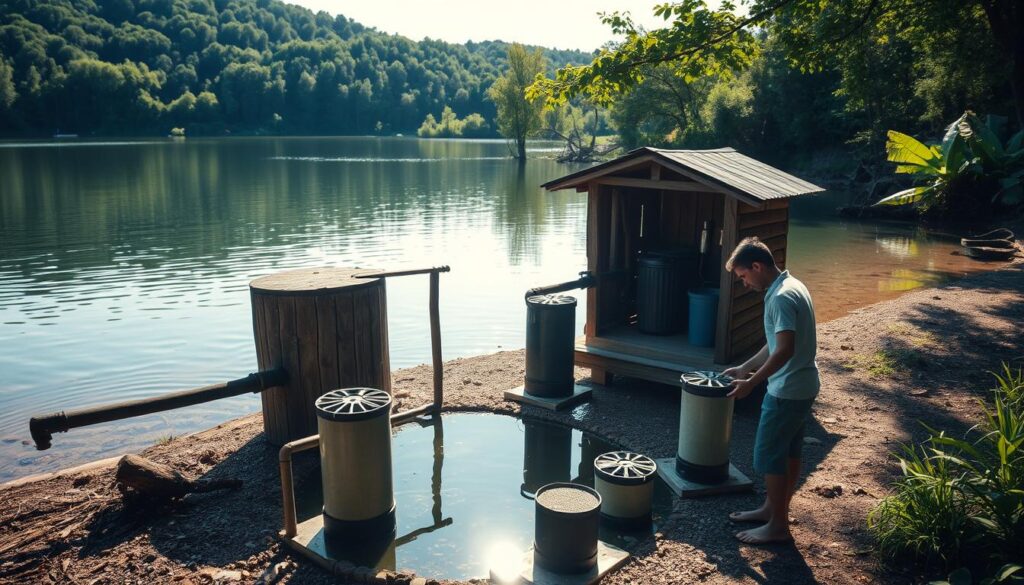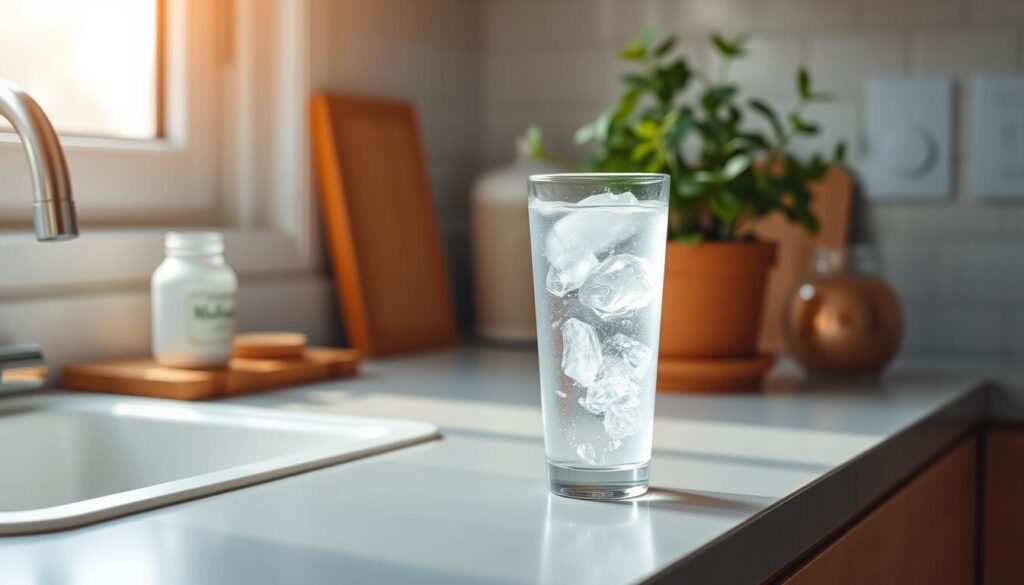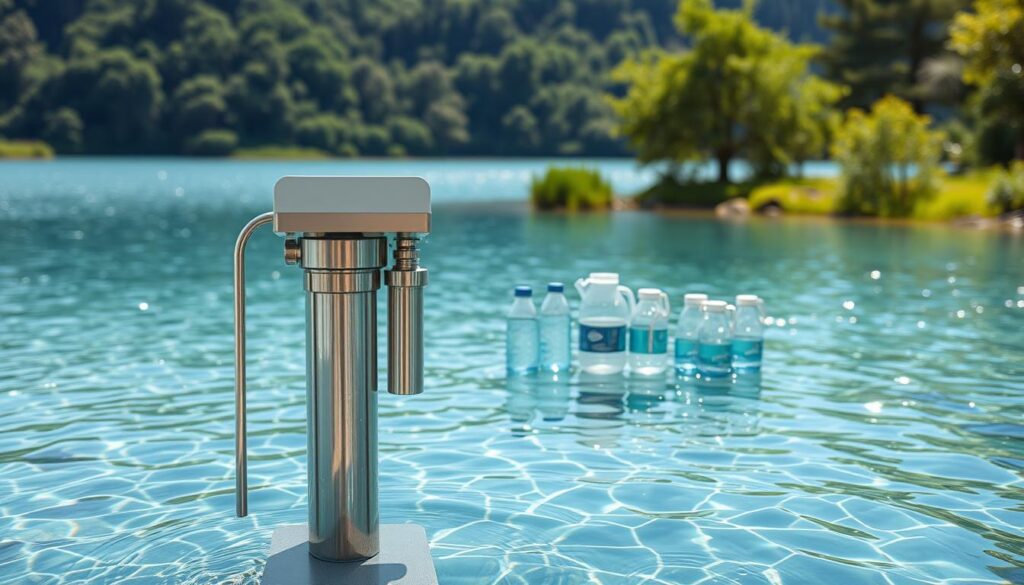When you’re in a survival situation, finding clean drinking water is key. Without it, you won’t last more than three days in the wild.
I remember a time when clean drinking water was everything. It was during a hiking trip when I got lost in the woods. Having safe drinking water is super important.
In this article, I’ll share my tips on purifying survival water. This will help you stay safe and healthy outdoors.
Key Takeaways
- Understanding the importance of clean drinking water in survival situations
- Methods for purifying water in the outdoors
- Tips for effective outdoor water treatment
- Staying safe and healthy with proper water purification techniques
- Personal experiences and expert advice on survival water purification
Why Water Purification is Essential for Survival
Being able to purify water is key for survival in the wilderness and during emergencies. Having clean drinking water is vital. Water purification keeps you safe.
Wilderness water can have harmful stuff like animal waste, faecal matter, and heavy metals. It can also have algal overgrowth and bacterial or viral infections. These can cause serious health problems. So, purifying water is a must.
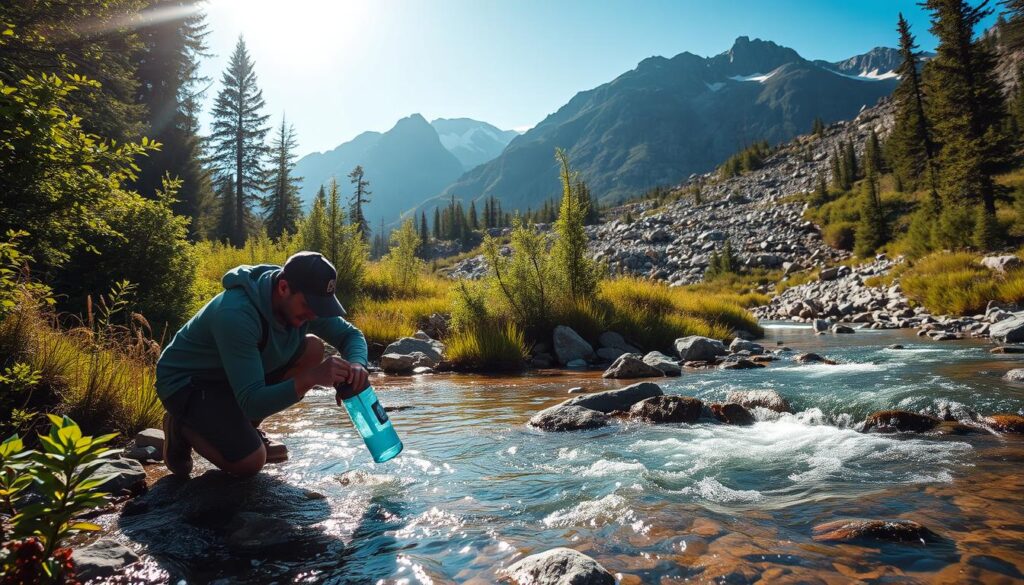
Understanding Waterborne Diseases
Waterborne diseases are a big risk with contaminated water. Diseases like cholera, dysentery, and typhoid fever can come from untreated water. Knowing these risks helps you take the right steps to purify water.
The World Health Organization (WHO) says waterborne diseases are a major cause of illness and death worldwide. Purifying water is very important.
“Access to safe drinking water is a fundamental human right, and essential for maintaining health and well-being.”
The Risks of Contaminated Water
Contaminated water can lead to serious health problems. It can cause outbreaks of waterborne diseases. It also risks long-term damage to the environment and ecosystems.
| Contaminant | Health Risk | Purification Method |
|---|---|---|
| Bacteria (e.g., E. coli) | Gastrointestinal illness | Boiling, Chemical Treatment |
| Viruses (e.g., Rotavirus) | Gastrointestinal illness | Boiling, UV Treatment |
| Heavy Metals (e.g., Lead) | Neurological damage, Organ damage | Filtration, Distillation |
Benefits of Purification in Emergencies
In emergencies, like natural disasters or getting lost, purifying water can save your life. It makes sure you have safe drinking water. This reduces the risk of getting sick and keeps you healthy.
Good water purification methods have many benefits. They lower the risk of getting sick, improve health, and increase chances of survival in emergencies. It’s important to be ready with the right tools and knowledge to purify water well.
Basic Principles of Water Purification
To purify water, it’s important to know the basic principles. Water purification isn’t just about removing visible dirt. It’s about understanding how different methods make water safe to drink.
To make water safe, three steps are needed: decontamination, sterilization, and beautification. Decontamination removes harmful substances. Sterilization kills bacteria and viruses. Beautification makes the water taste better, though it’s not always needed.
How Contaminants Affect Drinking Water
Contaminants in water can harm your health a lot. They can cause stomach problems or even deadly diseases. Knowing how contaminants affect water is key to picking the right purification method.
Waterborne pathogens like bacteria and viruses can make you sick. Using survival gear water filtration systems can help prevent these diseases.
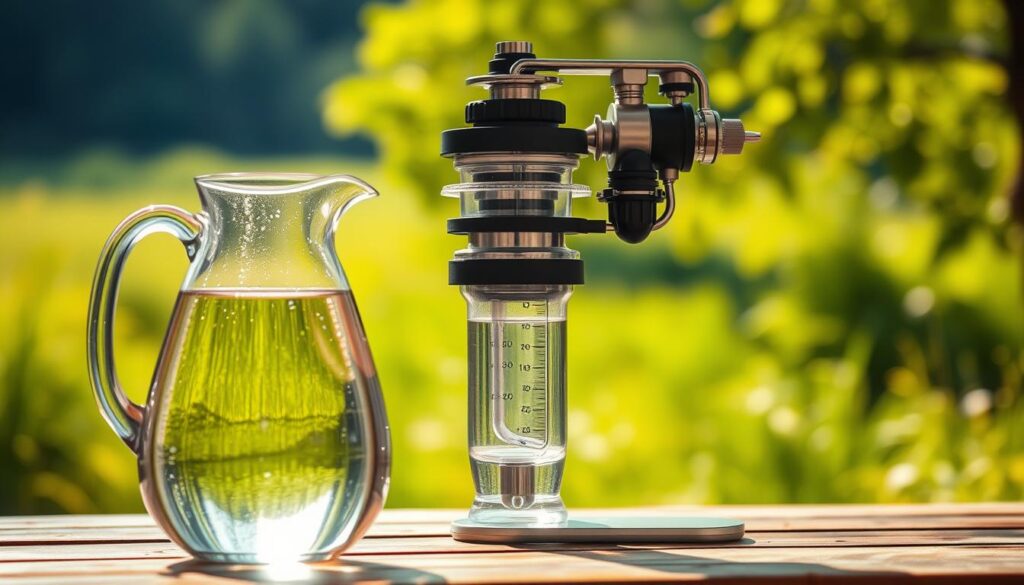
The Science Behind Purification Methods
The science of water purification involves physical, chemical, and biological processes. Boiling water kills pathogens with heat. Portable water filters use barriers to remove contaminants, making them great for emergencies.
Different methods target different contaminants. Chemical treatments, like purification tablets, kill microorganisms. Knowing each method’s strengths and weaknesses helps choose the best one for any situation.
Common Water Purification Techniques
Purifying water is key to staying healthy in survival situations. There are many ways to purify water, each with its own benefits and uses.
Boiling: The Simplest Method
Boiling water is a simple yet effective way to purify it. Boiling clear water is the most efficient way to make it safe to drink. Just bring it to a boil for 1-3 minutes, depending on your altitude.
Chemical Purification: Using Tablets and Drops
Chemical purification uses tablets or drops to kill bacteria and viruses. These chemicals are designed to be effective against a wide range of contaminants. Always follow the manufacturer’s instructions for dosage and waiting time.
| Purification Method | Effectiveness | Ease of Use |
|---|---|---|
| Boiling | High | Simple |
| Chemical Purification | High | Moderate |
| Filtration Systems | Variable | Moderate to Complex |
Filtration Systems: Choosing the Right Option
Filtration systems, like compact water purification systems and backpacking water filters, are handy for purifying water. When picking a filtration system, think about the contaminants you need to remove and how easy it is to use. A good filtration system can be a valuable investment for frequent travelers or outdoor enthusiasts.
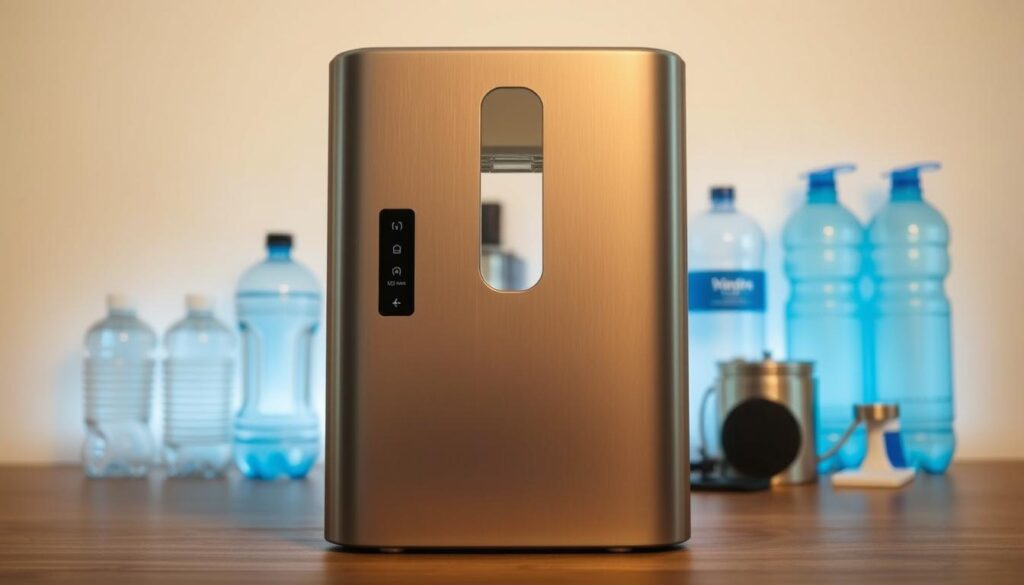
Knowing about different water purification techniques helps you make smart choices for staying safe and healthy in various places.
Advanced Water Purification Methods
Advanced water purification methods are key to safe drinking water in survival situations. They are great for wilderness trips or camping, where clean water is scarce.
UV Light Purification: How It Works
UV light devices are a tasteless and effective way to sterilize water. They’re perfect for camping water treatment because they don’t change the water’s taste or chemistry. UV light damages microorganisms’ DNA, stopping them from reproducing and making water safe.
Distillation: A Reliable Choice
Distillation is a solid method for purifying water. It boils water and collects the steam, which is clean. This method is great for wilderness water purification because it removes many contaminants, like salts and heavy metals.
Solar Purification: Nature's Method
Solar purification uses the sun’s UV rays to clean water. Just leave filtered water in the sun for three days to purify it. It’s a handy method when other ways aren’t available.
| Purification Method | Effectiveness | Ease of Use |
|---|---|---|
| UV Light Purification | High | Easy |
| Distillation | Very High | Moderate |
| Solar Purification | High | Simple |
In conclusion, methods like UV light, distillation, and solar purification are reliable for safe drinking water in survival situations. Knowing and using these techniques can greatly lower the risk of waterborne diseases while camping or in the wilderness.
Essential Gear for Water Purification
Choosing the right gear is key for successful water purification in the wild or during emergencies. It’s vital to have the right tools to get safe drinking water.
The right gear makes water purification more effective and efficient. I’ve used these methods before and know how important being prepared is.
Water Filters: Portable Options
Portable water filters are a must-have for any survival kit. They remove contaminants and pathogens, making water safe to drink. Look for filters with a 0.2 micron or smaller pore size to remove bacteria and viruses.
Choose filters from reputable brands known for quality. These filters are effective, lightweight, and compact. They’re perfect for backpacking and emergency kits.
Chemical Purification Tablets: A Must-Have
Chemical purification tablets are also essential. They contain disinfectants like chlorine or iodine that kill harmful bacteria and viruses. They’re easy to use and don’t need much equipment, making them great for emergencies.
Always follow the manufacturer’s instructions when using these tablets. This ensures the water is safe to drink by using the right amount and contact time.
Containers for Safe Storage
After purifying water, it’s important to store it in clean containers. Choose containers that are durable, BPA-free, and have tight-fitting lids. This prevents spills and keeps the water clean.
Collapsible water containers are a good choice for survival kits. They’re lightweight and easy to carry. Also, look for containers with measurement markings to help with mixing treatments or tracking water levels.
Investing in the right water purification gear is essential for survival. Whether you’re an experienced outdoorsperson or just preparing for emergencies, having the right gear is a game-changer.
Steps for Effective Water Purification
Knowing how to purify water is key for wilderness survival. Clean drinking water is essential for life. It’s vital to learn how to purify water well.
Assessing Water Quality Before Purification
First, check the water’s quality. Look for signs like sediment, algae, or odd smells. If it’s cloudy, filter it first. Use a portable water filter for filtering.
Step-by-Step Boiling Instructions
Boiling is a simple yet effective way to purify water. Here’s how to do it:
- Bring the water to a rolling boil.
- Keep boiling for at least one minute to kill pathogens.
- Let it cool before storing it in a clean container.
Boiling works well but needs fuel and takes time.
How to Use Chemical Purification Properly
Chemical purification with tablets or drops is also effective. Always follow the product’s instructions. Here’s what to do:
- Filter the water until it’s clear.
- Add the right number of tablets or drops.
- Shake or stir the mixture.
- Wait at least 20 minutes before drinking.
For example, purifying 20 liters with tablets requires following the product’s guide. This method is handy for outdoor water treatment when other options fail.
“The right to clean water is a fundamental human right.” This highlights the need for clean drinking water, critical in survival.
Common Mistakes in Water Purification
Purifying water is more than just making it safe to drink. It’s also about avoiding mistakes that can make the process fail. In survival situations, having clean drinking water is key. Knowing the pitfalls of water purification can save your life.
Overlooking Filtration Needs
One big mistake is not realizing the need for proper filtration. A compact water purification system works well, but you must filter first. If the water is dirty or full of sediment, filtering it out helps other purification steps work better.
Before choosing how to purify water, check its quality first. If it’s cloudy or full of particles, use a survival gear water filtration system to clean it up.
Not Following Instructions on Chemical Treatments
Chemical treatments like tablets or drops are used to purify water. But, not following the instructions can lead to bad results or even harm. For example, using pool-cleaning tablets for drinking water is very dangerous.
To use chemical treatments right, always follow the instructions exactly. This means using the right amount and waiting the right time before drinking. For more tips on water purification, check out this resource from the National Park Service.
Ignoring Temperature and Time Requirements
Temperature and time are very important when boiling water. Boiling is a great method, but you must pay attention to details. If you ignore these, your water might not be fully clean.
- Always bring the water to a rolling boil.
- Maintain the boil for the recommended time, usually at least one minute, or longer if you’re at high altitude.
- Let the water cool before storing it in a clean container.
By knowing these common mistakes and avoiding them, you can make sure your drinking water is safe and clean, even in survival situations.
DIY Water Purification at Home
You don’t need expensive gear to purify water at home. Simple DIY methods work well. I use them for camping trips or to have clean water at home.
Simple Methods to Try
One easy way is to make a filter with common items. Use a cone-shaped container, sand, rocks, and moss or cloth. This method works because it’s similar to commercial filters.
To make this filter:
- First, get your materials: a cone-shaped container, sand, small rocks, and a piece of cloth or moss.
- Put the rocks at the bottom to stop clogs, then add sand to filter out small particles.
- Use the cloth or moss to keep the sand and rocks inside.
- Now, pour the water you want to purify through this filter.
This method can remove many contaminants. But, it might not get rid of all bacteria or viruses. So, if the water source is questionable, boil it afterward.
When to Use DIY Techniques
DIY water purification is great for emergencies or when you’re far from town. It’s also a good backup if your main method fails.
For instance, if your backpacking water filter breaks on a camping trip, a DIY filter can save the day. At home, if your water treatment system goes down, a DIY method can provide clean water.
Remember, DIY methods are best used wisely. If the water is very contaminated, a simple filter might not be enough. In such cases, you might need to use camping water treatment with chemical tablets or UV light.
Key Takeaways for Survival Water Purification
Exploring ways to purify water in survival situations shows how important preparation is. It’s not just about having the right tools. It’s also about knowing how to use them right.
Preparedness is Key
Having a reliable way to purify water is key for survival. Using two methods, like boiling and chemical treatment, makes your water safer. Remember, “two is one and one is none.”
Customizing Your Approach
Wilderness water purification needs a tailored approach. You must consider your specific needs and choose the best method or combination. Think about the water source, equipment you have, and what you prefer.
Staying Up-to-Date
The field of water purification keeps changing with new tech and methods. Keeping up with the latest in survival water purification helps you make better choices. It keeps you safe in the wilderness.
FAQ
What is the most effective method for purifying survival water?
Boiling is a top choice for purifying water in survival situations. It kills most harmful bacteria and viruses. Portable water filters and chemical tablets are also good options.
How do I choose the right portable water filter for emergency situations?
When picking a portable water filter, think about the filter size, how fast it works, and how easy it is to clean. Choose one that removes harmful stuff and is certified by trusted groups.
Can I use DIY methods for water purification in survival situations?
DIY methods like simple filters can help sometimes. But, they might not work in all cases. It’s key to know their limits and use them wisely.
What are the benefits of using UV light purification for water?
UV light kills bacteria, viruses, and other bad stuff quickly and easily. It’s a great choice for emergencies because it’s fast and simple to use.
How do I store purified water safely?
To keep purified water safe, use clean, airtight containers made for water. Label them with the date and what’s inside. Store them in a cool, dark spot.
What are some common mistakes to avoid when purifying water?
Don’t forget to filter water, ignore chemical treatment instructions, and miss critical temperature and time needs.
Can I use chemical purification tablets for long-term water treatment?
Chemical tablets are for short-term use. For long-term, use a portable water filter or other methods made for longer use.
How do I assess the quality of water before purifying it?
Check for visible signs like sediment, color, or smell. Use water testing kits for bacteria, viruses, or other contaminants.
What is the importance of preparedness in water purification?
Being ready with the right gear and knowledge is key. It helps you act fast and effectively in emergencies, ensuring safe drinking water.
How can I stay updated on the latest water purification techniques?
Keep up by reading outdoor and survival websites, blogs, and forums. Also, go to workshops or training sessions to learn about new methods and tech.

